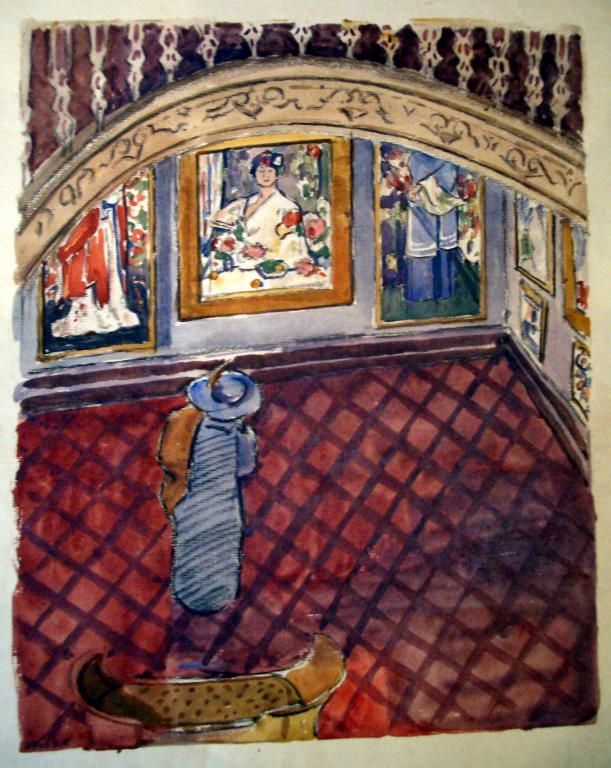Douglas Fox Pitt The Stafford Gallery 1912
Douglas Fox Pitt,
The Stafford Gallery
1912
The setting of this painting is the Stafford Gallery in London. Fox Pitt’s elevated viewpoint from the stair looks down onto a vermilion floor and a lone female viewer, draped in fox fur, taking in an exhibition of pictures by the Scottish Colourist J.D. Fergusson. Fox Pitt’s commemoration of Fergusson’s progressive painting could be read as an endorsement of the avant-garde.
Douglas Fox Pitt 1864–1922
The Stafford Gallery
1912
Graphite, charcoal and watercolour on paper
488 x 405 mm
Inscribed by the artist in pencil ‘D Fox Pitt’ and ‘Stafford Galleries | London’ bottom left and ‘98’ bottom right
Presented by Sarah Fox-Pitt and Anthony Pitt Rivers 2009
T12995
1912
Graphite, charcoal and watercolour on paper
488 x 405 mm
Inscribed by the artist in pencil ‘D Fox Pitt’ and ‘Stafford Galleries | London’ bottom left and ‘98’ bottom right
Presented by Sarah Fox-Pitt and Anthony Pitt Rivers 2009
T12995
Ownership history
...; Sotheby’s, London, 15 May 1985 (100, part of a large folio of watercolours and drawings by Fox Pitt); purchased by the artist’s great niece Sarah Fox-Pitt and Anthony Pitt Rivers, by whom presented to Tate 2009.
Technique and condition
The Stafford Gallery is executed on cream laid paper, which has an unidentified elaborate watermark. The work has been painted on the centre of the sheet of paper, leaving an unpainted border around the edge.
The vivid colours of the watercolour are still apparent, though the red of the floor in the bottom right-hand corner is rather dark, possibly owing to the paper becoming too wet when the watercolour was painted. The paper has been left unpainted in some areas, such as the clothes in the paintings on the wall. Charcoal has been used to accentuate outlines and for shading on the figure’s clothes. In places, such as the sofa, the charcoal has been applied while the paint was still wet.
The paper is quite discoloured and there is significant surface dirt on the border and a repaired tear on the lower edge of the sheet. The right-hand edge of the paper is the most damaged, suggesting that this edge protruded from the portfolio in which the drawing was stored.
Jo Gracey
February 2009
Piers Townshend and Helena Bonett
June 2010
How to cite
Jo Gracey, Piers Townshend and Helena Bonett, 'Technique and Condition', June 2010, in Robert Upstone and Helena Bonett, ‘The Stafford Gallery 1912 by Douglas Fox Pitt’, catalogue entry, October 2009, in Helena Bonett, Ysanne Holt, Jennifer Mundy (eds.), The Camden Town Group in Context, Tate Research Publication, May 2012, https://wwwEntry
Although he was never one of its formal constituents, Douglas Fox Pitt was part of the circle around the Camden Town Group. When they disbanded and reconvened as the more radical London Group in 1913 – containing the advanced modern elements of David Bomberg, Jacob Epstein and the vorticists – Fox Pitt became a founder member. His own art nevertheless followed the progressive but still conservative figurative style established by the Camden Town painters, most notably adopting their bright, post-impressionist palette. Fox Pitt’s pictures of street scenes and city landscapes to some degree also recall Camden Town Group subject matter. A man of independent means, he worked generally in watercolour, and his pictures became known through a series of London exhibitions of scenes painted on foreign travels in India, Morocco and elsewhere. Closer to home, views of Brighton formed the most common subject in his art.
This watercolour of the Stafford Gallery, however, is a rare document of an early exhibition by the Scottish Colourist J.D. Fergusson at a London venue known for its displays of avant-garde art around 1912. The Stafford Gallery was a short-lived centre for the showing of modern French art. It held one of the first exhibitions of Paul Gauguin’s paintings in 1911, and this was commemorated by Spencer Gore in his well-known painting Gauguins and Connoisseurs 1911 (fig.1). Other shows included an exhibition of Pablo Picasso drawings in 1912, and early London exhibitions of Gustave Courbet, Camille Pissarro and Paul Cézanne.

Spencer Gore 1878–1914
Gauguins and Connoisseurs 1911
Oil paint on canvas
838 x 717 mm
© Private collection
Fig.1
Spencer Gore
Gauguins and Connoisseurs 1911
© Private collection
The viewpoint of Fox Pitt’s watercolour is from the vantage point of the stairs down to the gallery, which can be seen at the top of the picture. Evidently, he utilised the same spot as Gore had done – most likely on a landing – and the watercolour’s standpoint and overall composition is identical to Gore’s painting, including the small sofa and motif of looking down on the figure beneath.
Despite the essentially traditional nature of Fox Pitt’s work he was nevertheless a staunch apologist and ally of the avant-garde. In 1910 he wrote to the New Age to defend Roger Fry’s controversial post-impressionist exhibition:
We have been told by fashionable portrait painters and timid art critics that the paintings now shown at the Grafton Galleries are ‘hysterical daubs’. The gibes and sneers of prejudiced people will not kill the Post-Impressionists any more than similar treatment killed Whistler, Manet, or Monet. To be unable to see any beauty of colour in Cézanne or Gauguin suggests a defective aesthetic sense ... all art movements have grown out of differences. It is when these differences are emphasised that you get new schools, and these sometimes make for progress.6
As an artist who had lived in Paris and been exposed to the most recent cubist developments in modern art, Fergusson was one of the most advanced members of the London avant-garde. Fox Pitt’s commemoration of the showing of his pictures at the Stafford Gallery again appears to ally himself with the progressive nature of Fergusson’s art, and also raises its significance as the subject of art as an event of significance for the development of contemporary culture. This, too, had been an aspect of Gore’s painting of the Gauguin exhibition.
Robert Upstone and Helena Bonett
October 2009
Notes
Reproduced in The Scottish Colourists 1900–1930: F.C.B. Cadell, J.D. Fergusson, G.L. Hunter, S.J. Peploe, exhibition catalogue, National Galleries of Scotland, Edinburgh 2000 (27).
Reproduced at University of Stirling, http://www.artcol.stir.ac.uk/collection2.html , accessed 24 January 2011.
Related biographies
Related essays
- Leisure Interiors in the Work of the Camden Town Group Jonathan Black, Fiona Fisher and Penny Sparke
- The Carfax Gallery and the Camden Town Group Samuel Shaw
- The Socio-Geography of Art Dealers and Commercial Galleries in Early Twentieth-Century London Anne Helmreich
How to cite
Robert Upstone and Helena Bonett, ‘The Stafford Gallery 1912 by Douglas Fox Pitt’, catalogue entry, October 2009, in Helena Bonett, Ysanne Holt, Jennifer Mundy (eds.), The Camden Town Group in Context, Tate Research Publication, May 2012, https://www


